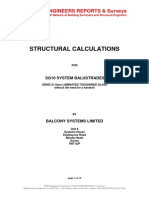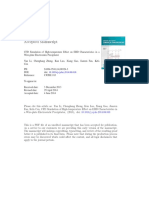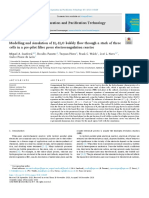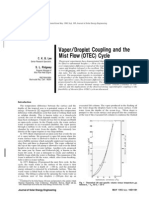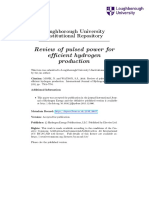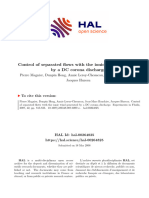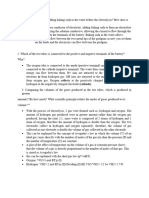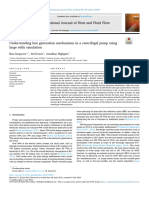Electrohydrodynamic Enforcement of Evaporation and Gas Flow
Electrohydrodynamic Enforcement of Evaporation and Gas Flow
Uploaded by
Michael ReznikovCopyright:
Available Formats
Electrohydrodynamic Enforcement of Evaporation and Gas Flow
Electrohydrodynamic Enforcement of Evaporation and Gas Flow
Uploaded by
Michael ReznikovCopyright
Available Formats
Share this document
Did you find this document useful?
Is this content inappropriate?
Copyright:
Available Formats
Electrohydrodynamic Enforcement of Evaporation and Gas Flow
Electrohydrodynamic Enforcement of Evaporation and Gas Flow
Uploaded by
Michael ReznikovCopyright:
Available Formats
1036
IEEE TRANSACTIONS ON INDUSTRY APPLICATIONS, VOL. 47, NO. 2, MARCH/APRIL 2011
Electrohydrodynamic Enforcement of Evaporation and Gas Flow
Michael A. Reznikov, Senior Member, IEEE, Alex Kolessov, and Richard Koziol
AbstractThe net drag result of the ionic current in a conductive uid, such as electrohydrodynamic (EHD) effect and electrospray (Taylor cone effect), has been investigated as a space and energy saving technology for enforced heat and mass management. Electrostatically enforced evaporation, convection, and phase-change thermal transfer are briey discussed and experimentally evaluated. The emphasis of the investigation was on the maximal efciency of the consumed power. The signicance of EHD phenomena for energy saving is demonstrated with examples of temperature stabilization for solid-state lighting and the dewatering of pulp in the paper industry. Index TermsCorona, electrostatic devices, heat pumps.
dewatering, electrostatic atomization, and electrohydrodynamic (EHD) pumping, as well as the full theoretical consideration of these processes, are beyond the scope of this paper. II. T HEORETICAL BACKGROUND A. Electrostatic Enforcement of Evaporation An asymmetric distribution of electric charges in the vapor molecule (water and alcohols) allows using dielectrophoresis [1]the drift of dipoles in the gradient of the electrical eldto directly affect the water vapor by an external electric eld. Complementing the fact that a high gradient of electrical eld can be obtained near electrodes with large curvatures [2], the ionic current through the airstream serves as an additional multipoint distributed absorber because every single ion produces a high eld gradient around it. Therefore, the enrichment of vapor is created near each microelectrode, which was demonstrated experimentally [3]. The dielectrophoretic force Fdph = 20 E affects particles (molecules) with dipole moment 0 , resulting in the potential energy U of the dipole
I. I NTRODUCTION UE TO the energy barrier for evaporation, the transition from liquid to vapor phase requires additional enthalpy (latent heat). On the one hand, this allows extracting heat from the liquid, which is widely used in heat pipes and spray cooling because of the isothermal nature of the process. While the phase transition energy is supplied by the cooled material itself, the vapor should be removed to prevent a steady-state equilibrium. The diffusion of vapor is supported by convection, which mostly limits the density of mass ow and, correspondently, the heat ux. The enforced convection is usually achieved by the intensive ow of the carrier gas (for example, air), requiring useless power consumption, because an enormous amount of carrier medium must be moved along with the vapor. On the other hand, if we need to extract the liquid itself, additional energy must be applied. As a result, although thermal dewatering technologies are much more productive than mechanical or physical property-based techniques, they consume large quantities of energy because the entire bulk of the dewatered material acquires an elevated temperature. Thus, the major problem to be solved is the application of energy directly to vapor while keeping the efciency of thermally driven evaporation high. In Section II, we are briey discussing physical processes and phenomena related to these technologies in order to add clarity and compactness to the discussion of experimental results described in Section III. The review of
Manuscript received July 14, 2009; revised July 15, 2009, January 20, 2010, and February 22, 2010; accepted April 26, 2010. Date of publication January 6, 2011; date of current version March 18, 2011. Paper 2009-EPC232.R3, presented at the 2009 Joint Conference on Electrostatics, Boston, MA, June 1618, and approved for publication in the IEEE T RANSACTIONS ON I NDUSTRY A PPLICATIONS by the Electrostatic Processes Committee of the IEEE Industry Applications Society. This work was supported in part by the U.S. Department of Energy under Grants DE-FG02-06ER84568 and DE-FG0208ER85073. The authors are with Physical Optics Corporation, Torrance, CA 90501 USA (e-mail: mreznikov@poc.com; akolessov@poc.com; rkoziol@poc.com). Digital Object Identier 10.1109/TIA.2010.2103912
U (x) = 20
x
grad|E | dx
(1)
and the stationary distribution of molecules with density n(x) = n exp(U (x)/kT ) occurs when the drift and diffusion ows are equal. Assuming a natural dipole moment of the water molecule 0 = 6.6 1028 C cm [4], the potential energy of such molecule at the radius R from the point charge q can be calculated similarly to (1) as UR = 20 q . 0 R 2 (2)
At a given temperature and in the absence of airow, the pressure of the water vapor is proportional to the concentration of vapor molecules, and there is a local enrichment, induced by eld = pR /pV = exp(UR /kT ) (3)
where indexes R and V are related to the pressure at a distance R and at an innite distance in the volume of vapor, respectively. If the humidity (pressure pR ) reached the dew point at a given temperature, condensation starts, and the density of vapor phase decreases, which correspondingly decreases the diffusion ow and increases the dielectrophoretic drift vapor ow toward the microelectrode.
0093-9994/$26.00 2011 IEEE
REZNIKOV et al.: ELECTROHYDRODYNAMIC ENFORCEMENT OF EVAPORATION AND GAS FLOW
1037
allows one to model the charge transfer and mass ow in the specic design of an EHD pump. C. Electrostatic Atomizer Evaporative cooling is driven by the difference in the pressures of saturated vapor over the liquid phase. This difference can be enhanced because the saturated vapor pressures over the at p0 and curved pr surfaces of the liquid are related to the curvature 1/r and surface tension according to the Kelvin equation: ln(pr /p0 ) = 2Vm /rRT , where Vm is the molecular volume and R is the universal gas constant. As a result, the same vapor pressure in the evaporator (over a high curvature surface) can be below the critical pressure, allowing the droplets to evaporate, whereas it is above the critical pressure over the at liquid surface in the condenser, where vapor aggregates into the liquid. This coalescence of small droplets into the bulk liquid is a permanent process, because droplets are constantly created by the atomizer. An attractive way to create small droplets of evaporated liquid is an electrostatic spray [5]. Electrically charged droplets do not coalesce because of their electrical repulsion. Having a charge also means that these drops can be electrically deected toward a target. Due to the Coulomb interaction of injected charge with the applied electric eld and the force of surface tension, the liquid forms a straight cone (a Taylor cone). At a certain threshold voltage, the slightly rounded tip of the cone inverts and emits a jet of liquid. Once airborne, the liquid droplets keep their structural integrity until the surface tension exceeds the electrostatic repulsion of the surface charges. Up to a point, known as the Rayleigh limit, surface tension prevents droplet fragmentation. Due to evaporation, however, continuous shrinkage in droplet size increases repulsion proportionally, and eventually, the Rayleigh limit is overcome and the droplet undergoes Coulombic explosion, splitting into progeny droplets. This technique is widely used in the mass spectrometry of organic materials to disperse molecules. We have evaluated the possibility to use electrospray for the so-called spray cooling that allows avoiding any mechanical pumps and ne high-pressure nozzles. III. E XPERIMENTS A. Electrostatic Enforcement of the Paper Drier Approximately 4500 trillion kJ/yr (PJ/yr) or about 18% of all in-plant energy use in the U.S. is consumed by the thermally driven distillation, evaporation, and drying technologies. Due to the enormous industry demand for dewatering, even a 20% decrease of the needed energy will save about 900 PJ/year (or 5000 billion USD annually at a current price of $0.02/kW h) at the current level of industry production. We evaluated the dielectrophoretically enforced drying during the fabrication of paper. To the best of our knowledge, this is the rst attempt anywhere to apply dielectrophoretic forces to intensify the dewatering of materials. First, a laboratory test setup was designed for evaluating the dielectrophoretic extraction of water from the paper web. The
Fig. 1. Schematic cross section of the EHD vapor pump. The corona discharge occurs only near the coronator (wire electrode), and the current outside this ionization area consists of only single-sign charge carriers.
If airow exists, the enrichment, according to (3), is never achieved because the vapor is constantly moved out. This creates a permanent vapor ow from the evaporation surface and results in the displacement of dynamic equilibrium between evaporation and condensation. As an outcome, the effective evaporation rate (evaporation minus condensation) increases. B. EHD Flow An airow can be created by the drag action of ions when the corona discharge occurs in the gas (air)the momentum and kinetic energy are passed to the molecules of the neutral gas due to the interactions with drifting ions. In the EHD vapor pump, the discharge (corona) current ows from a highcurvature 400 cm1 electrode (tungsten wire) at high voltage to a grounded collector electrode, which is shaped as an arc for uniformity of the ionic current (see Fig. 1). Because the electric eld around the electrode wire decreases very sharply with distance r as 1/r, gas breakdown (corona discharge) occurs only in close proximity to the wire. Therefore, ionization is limited to a small area near the electrode, and the current consists of only single-sign charge carriers outside the ionization area, recombination rate is low, and most of the ions reach the other grounded electrode. In the interelectrode gap, the ions interact with neutral molecules, thus passing their kinetic momentum to the uid (gas). The average velocity of a single ion is dened by the ion mobility K and electric eld, as av = KE . This average velocity is a steady-state (terminal) velocity, and thus, all additional kinetic energy acquired from the electric eld is passed to the neutral molecules by the drag interactions. Consequently, at least for the laminar ow, the force applied to the ions is also the force per unit volume acting on the bulk uid, which, at the concentration of ions n, can be calculated from F ions = E q n = F body . (4)
This bulk body force couples the electrostatic equations to the NavierStokes equations that govern the ow of the neutral medium u =0 u u = P + 2 u + F body (5) (6)
where P represents the static pressure and u, , and represent the uid velocity, density, and viscosity, respectively. This
1038
IEEE TRANSACTIONS ON INDUSTRY APPLICATIONS, VOL. 47, NO. 2, MARCH/APRIL 2011
Fig. 2. Test setup for the electrostatic drier enhancer. High-voltage coronators serve both as the dielectrophoretic vapor extractors and discharge sources for the EHD pump. Note that the actual electrostatic device is very simple. It consists of grounded waved mesh and array of thin (50 m) tungsten wires that are shown in Fig. 3.
Fig. 4. Dewatering (moisture removal) rate during the dynamic test of an electrostatic dryer enhancer. Note that we have used the lowered temperature of the heater, 96 C, instead of the 120 C that is usually used.
Fig. 3. Electrostatic drier enhancer.
Fig. 5. Installation of the tested prototype between the heated drums of paper dryer.
setup imitates the industrial steam-drum drier and is equipped with sensors that control the temperature, relative humidity, and airow. The scheme for this setup is shown in Fig. 2, and Fig. 3 shows a photograph of the device. The test was carried out with a moving belt and constant remoistening of the paper. The temperature of the heater (< 100 C) was lowered relative to that used in the paper industry to demonstrate the power efciency of electrostatic drying. The results of this test are shown in Fig. 4, which clearly demonstrates that the dewatering rate at 96 C significantly (approximately eightfold) exceeds the evaporation due to heating once high voltage is applied. For 120 C temperature, the dewatering improvement estimate should be adjusted to 6.4 times. Also, thermal losses due to convection are also lower at the decreased temperature difference between the heater and the ambient air. As a result, the power consumption decreases to (96 22)/(120 22) = 75.5% or a 24.5% saving. Moreover, due to the decreased processing time, the total energy saving reaches 100 75.5/6.4 = 88.2%. Of course, the power consumption of a high-voltage power supply (18 W at an output voltage 6.5 kV) must be accounted. The electric power consumption of the heater at a stabilized temperature of 96 C was 700 W. Therefore, the nal ef-
ciency of the energy saving was (700 0.88.2 18)/700 = 85.6%, which is slightly less than the one without accounting for the power consumed by the high-voltage converter. The nal test was made with the papermaking machine at the Pilot Paper Plant of the Western Michigan University. This setup is shown in Fig. 5. The device was tested at two positionsimmediately after the paper press and after the coating module. The infrared (IR) moisture meter IR-M1000 from CHINO Corporation was installed after the tested extractor module to monitor changes in the water content. Due to the high (60%) moisture content after the paper press, optical moisture meter was ineffective, and evaporation efciency was calculated from the temperature gradient created. The relatively low temperature (below 60 C) at the initial drying stage led to a negligibly low evaporation between drums, and the difference in the paper temperatures due to the evaporation without electric eld was undetectable by the optical pyrometer. In contrast to this, once the tested unit was activated, a signicant temperature gradient was created along the paper sheet. Knowing the velocity of the paper web (30 cm/min) and the initial water content (measured by the weighting method), the evaporation rate was calculated
REZNIKOV et al.: ELECTROHYDRODYNAMIC ENFORCEMENT OF EVAPORATION AND GAS FLOW
1039
Fig. 6. Evaporation rate at varied applied voltage and temperature of the paper after the press.
Fig. 8. Moisture content prole in the coated paper (a) without and (b) with electrostatic support. The numbers at the left show the absolute water content.
edge moisture content is about 19% below the average (due to the easier convection at the edges of a paper roll) without the electric eld, it drops by 27% when the electric eld is turned on. B. Electrostatic Enhancement of the Phase-Change Cooling of High-Brightness LEDs While LEDs generate little or no IR or ultraviolet radiation and convert up to 25% of the power to visible light, the remainder is converted to heat that must be conducted away from the LED die to the underlying circuit board and heat sinks, housings, or luminaire frame elements. As a result, the performance of LEDs must rely on heat transfer via conduction or convection, and this insufcient thermal management curbs the superior advantages associated with high-brightness LED lighting, such as high energy efciency, low-temperature operation, robustness, digital control, low-voltage operation, and long life. The evaporative phase-change cooling driven by the EHD vapor transport and electrostatic atomization was experimentally evaluated. The technology uses the electrostatic production (Taylor cone effect) of nanoliter-sized droplets of working uid (alcohol and water) in an electric eld to quickly evaporate them on the back side of the LED die, package, or array. Because the latent heat of evaporation is absorbed at a constant temperature, the heat removal rate in this application depends only on the circulation of the uid, which is enforced by an electrostatic jet for the liquid phase and EHD fans for the vapor. This creates an electrically enforced heat pipe structure with the spray-driven evaporation. The design of the device is shown in Fig. 9, and the assembled prototype is shown in Fig. 10. Three working uidsdistilled water, methanol, and ethanol were tested for electrospray. The volumetric consumption of each uid at varied applied voltage between the atomizing needle and the evaporator is shown in Fig. 11. This plot shows that the best spraying is achieved with methanol as a working uid. The saturation of the spray rate with the elevation of applied voltage is clearly observable. This saturation can be explained by a xed charge surface density at the moment of droplet separation for the given temperature. In this case, the ow rate is limited by the uid viscosity; therefore, increasing the voltage leads to the frequent generation of smaller droplets and their higher acceleration, while the total volume of the sprayed uid does not increase.
Fig. 7. Evaporation rate at the applied voltage and without the voltage for varied temperature of the paper roll after the coater.
from the balance of enthalpy, accounting for the latent heat of evaporation. Data are collected at two temperatures of the paper without an applied electric eldat 136 F and 130 F (54.4 C and 57.2 C). Fig. 6 shows the linear approximation of test data separated into two groupsat 136 F and 130 F. The common corona initiation voltage of 3.5 kV is clearly observable, as well as the signicant 50% increase in the sensitivity to the applied voltage. The installation of the electrostatic module at the coating stage also demonstrated a clear evaporation improvement, shown in Fig. 7. The average improvement in the evaporation rate at the coating stage is 15%, because of the low water content and, correspondingly, better heat exchange between the paper and heating drum. As a result, the natural convection evaporation is limited by the rate of moisture diffusion to the surface of the paper, decreasing the effect of the applied electric eld, which suppresses reverse condensation but cannot increase the rate of evaporation itself. In order to detect the effect of electrostatically enforced evaporation by the independent moisture meter (isotope scanner installed at the end of the paper trail), the last drying drum was turned off, thus increasing the moisture content at the machine output [see Fig. 8(a)] and revealing the drying effect [see Fig. 8(b)]. The tested module was installed at the frontfacing part of the paper roll (right side in Fig. 8). The increased maximal moisture content outside of the tested module is the result of the cooling action: Increased evaporation lowers the total enthalpy of the paper. Nevertheless, if the
1040
IEEE TRANSACTIONS ON INDUSTRY APPLICATIONS, VOL. 47, NO. 2, MARCH/APRIL 2011
TABLE I PARAMETERS OF THE T ESTED F LUIDS
Fig. 9. Design of an electrostatic cooler that contains the electrostatic sprayer (atomizer) and EHD driver (pump) for gas and vapor.
Fig. 10. Electrostatic cooler prototype that cools the LED array by 28 C, increasing the efcacy (light output per consumed power) by 25%.
Fig. 11. Spray rate versus applied voltage for the 150-m needle at a distance of 36 mm from the concave grounded surface. (1) Distilled water. (2) Ethanol. (3) Methanol.
Ethanol and methanol allow the smooth transition from the regime of separate drops (there is no atomization) to the Taylor cone regime with atomization. In contrast to alcohols, water establishes the atomization regime almost instantly, once the threshold voltage is reached. This can be attributed to the
signicantly higher surface tension of water, which does not allow for the early separation of droplets, and Taylor cone is extended instead. The obtained data can be recalculated for the power consumption available for the evaporation. For this purpose, the volumetric rate should be converted to mass rate, divided by the evaporation area (6.25 cm2 ) and then multiplied by the specic latent heat of evaporation of the working uid. The parameters of tested uids are listed in Table I. The signicant difference in the spraying rates, 4.86 times between methanol and ethanol, can be attributed to the higher positive charge afnity (lower barrier for the extraction of an electron) of methanol compared to that of ethanol, despite similar surface tension and density. Water spraying rate is signicantly lower and requires an elevated voltage. It should be noted that this test was carried out at room temperature (22 C), and using water at signicantly higher temperatures may be feasible due to the lowering of surface tension. All tests were carried until the atomization regime was established. Twenty-one-gauge hypodermic needles (inner diameter of 0.514 mm) were used in all experiments. As the electric voltage increases, the liquid ejection starts from the electrostatically expanded meniscus that is shown in Fig. 12(a) and (b). When the electric charge density in the meniscus sufciently increases, the drop separates. This process repeats with frequency that increases with raised voltage, due obviously to the increased rate of charge injection, until the permanent Taylor cone is established [see Fig. 12(c)]. While this is a stable regime, the position of Taylor cone migrates, and even two cones can be established simultaneously [see Fig. 12(d)]. The length of the established Taylor cone was 0.25 mm for all tested liquids, but it is always located on the top of the meniscus. Electrospray created very ne practically invisible mist. The spraying angle depends on the conguration of the electrodesthe distance from needle to the evaporator and
REZNIKOV et al.: ELECTROHYDRODYNAMIC ENFORCEMENT OF EVAPORATION AND GAS FLOW
1041
Fig. 12. Microphotographs of the electrospray. (a) Initial axial extension of the meniscus before the separation of the drop. (b) Established Taylor cone. Magnication 60X .
Fig. 14. Spray rate versus applied voltage for methanol at varied distance to the extracting electrode: (1) 2, (2) 4, (3) 6, and (4) 10 mm. The dotted line shows the dripping regime.
Fig. 15. Typical electrical current pulses in the collecting (transferred charge) and extracting (induced charge) electrodes. Note that the transferred charge current is always positive while the induced charge alternates. Fig. 13. Test setup with additional extracting ring electrode.
the evaporator diameter. Due to the goal of evaluating the integral efciency of electrospray cooling, the distribution for droplet size and radial distribution of mass transfer rate were not investigated in this paper; nevertheless, the full coverage of the evaporator was clearly observable as a wetted area. Because the spraying rate with the simplied bielectrode conguration is too sensitive to the position of the collecting electrode (evaporator in our case), the atomizer was tested with an additional extracting electrode, i.e., a ring installed in front of the needle tip (see Fig. 13). Four congurations of the electrostatic sprayer were tested, where the extracting ring electrode (6-mm diameter) was placed at a xed distance from the collector (20 mm), while the distance from the needle tip to the ring was varied2, 4, 6, and 10 mm. Fig. 14 shows the results of this test with methanol. The near-transversal extracting eld (at 2-mm distance) is notably more effective than the additional longitudinal eld (at 100-mm distance). This additional eld affects the separation of the drops in two waysdecreasing the surface tension at the needle tip (negative electrowetting effect) and applying additional force toward the evaporator. The rst effect prevails at short distances to the ring (2 mm), but the second effect works when the distance to the ring becomes comparable to the diameter of this ring (6 mm). The effect at the intermediate distance (4 mm), or at too long a distance (10 mm), is notably lower. If voltage is increased, the spray of methanol always starts from the ejection of small (0.5- to 1-mm diameter) charged droplets that y toward the evaporator due to the electrostatic force.
Because of the relatively big size and limited surface charge density, these droplets do not reach the Rayleigh limit and hit the evaporator. During the dripping regime, each charged droplet induces a charge of opposite sign in the extracting electrode when it passes through the ring. Fig. 15 shows the typical signals produced by charged drops in the extracting and collecting electrodes. The pulses in Fig. 14 are synchronized, which means that the corresponding pairs of pulses are produced by the same droplet. The pulse of the transferred charge reects the discharge of the droplet, producing a pulse of single polarity. In contrast, the induced pulse is bipolar, which reects the induction of charge (positive current) when the droplet moves toward the plane of the electrode and the relaxation of charge (negative current) when the droplet moves away from the electrode. This technique permits monitoring the frequency of droplet generation and estimating the average charge per droplet. The transition from the dripping regime (generation of relatively big droplets) to the spray regime (disintegration of the Taylor cone to the plume of nanodroplets) is shown in Fig. 16. Atomization starts when the liquid is extracted from the needle tip as a bulk stream and forms the Taylor cone. A constant supply of electric charge to the cone tip allows for the high charge density in the microjet ejected from the needle. Please note that, similar to Fig. 15, the induced charge pulses are always bipolar, while the transferred charge exposes a signicant constant bias component in the jet spray regime with the signals from the nanodroplets in the charged plume indistinguishable.
1042
IEEE TRANSACTIONS ON INDUSTRY APPLICATIONS, VOL. 47, NO. 2, MARCH/APRIL 2011
R EFERENCES
[1] H. A. Pohl, Dielectrophoresis. New York: Cambridge Univ. Press, 1978. [2] R. Patsch and M. Hoof, Clustering of water moleculesThe key to understand the water treeing phenomenon, in Proc. ISH , Yokohama, Japan, 1993, vol. 1, pp. 8388. [3] M. Reznikov, Dielectrophoretic dehumidication of gas stream in low and moderate electrical elds, presented at the ESA-IEEE Joint Meet. Electrostatics, Little Rock, AR, Jun. 2427, 2003, 230240. [4] G. Maroulis, Hyperpolarizability of H2 O, J. Chem. Phys., vol. 94, no. 2, pp. 11821190, Jan. 1991. [5] G. I. Taylor, Disintegration of water drops in an electric eld, Proc. R. Soc. Lond. A, Math. Phys. Sci., vol. 280, no. 1382, pp. 383397, Jul. 1964. Fig. 16. Illustration of signals from the transferred and induced charges: (a) shows dripping (emission of single drops) while (b) demonstrates the jet spray regime.
IV. C ONCLUSION Experimental evaluation of electrostatically enforced evaporation and cooling has demonstrated signicant advantages of this technique, such as compactness, easy scaling, and low power consumption. Electrostatic evaporation systems offer a number of advantages over the current dewatering technologies due to power saving, compactness, reduced cost, and environmental friendliness. This technique converts challenging water properties to useful driving forces. For example, the polarity of water molecules increases the heat of evaporation in the thermal technology, but the same polarity allows moving water vapor toward microelectrodes in the electrostatic evaporation system. Unlike current cooling systems that provide heat energy ow solely due to the temperature gradient, the electrostatic system increases the chemical potential of the heat-carrier uid by introducing a high surface-to-volume ratio and high surface curvature in nanoliter droplets. The resulting gradient of vapor chemical potential between the heat extracting evaporator and heat releasing condenser efciently supports a high rate of phase conversion; thus, the heat extraction process (evaporation) is isothermally driven by the extracted thermal energy itself. The matching mass transport is achieved by the utilization of ion scattering on molecules of vapor and carrier gas (air or helium). Not only does this highly intensify the thermal exchange but it also creates the possibility to minimize the temperature of the cooled hot spot, even down to the ambient temperature, because the driving force for the heat extraction is the phase-change process. Thus, the method can be considered as a reversible permanently self-regenerating coalescence technology that provides improved efcacy due to the isothermal heat management of the power dissipating device, while consuming minimal power for the mass transport, because the electrostatic forces are applied directly to the working uid. ACKNOWLEDGMENT The authors would like to thank the personnel of the Pilot Paper Plant of Western Michigan University, particularly J. F. Bergin and J. Kendrick for the possibility to test the electrostatic evaporator with the production equipment and Paperchine, Inc., and, personally, L. D. Wicks and T. K. Grunder for the invaluable advice and help in conducting this test.
Michael A. Reznikov (M99SM05) received the M.S.E.E. degree with a major in semiconductors and dielectrics from Kiev Polytechnic University, Kiev, Ukraine, in 1972, and the Ph.D. degree in physics and mathematics, majoring in solid-state physics, from the Academy of Sciences of Ukraine, Kiev, in 1980. At the Academy of Sciences of Ukraine, he researched the electron eld emissions from silicon, and electrostatic coalescence of metal clusters that resulted in the development of technologies for dielectric spectroscopy, nondestructive testing of thin lms, and electrostatic imaging. Since 2001, he has been a Principal Scientist at Physical Optics Corporation, Torrance, CA, and has successfully managed a number of projects in the electrostatic dehumidifying, polymer-gel-based electrolyte thermoelectric conversion, capacitive electrostatic sensing, electrically supported spray and evaporation technologies, and thermal management. He is the holder of 12 patents and has more than 40 publications to his credit in refereed international and national journals and proceedings of international conferences. Dr. Reznikov is a member of the American Physical Society and Electrostatics Society of America. His research on material degradation on the Salyut 6 and 7 space stations won the Ukrainian State Prize for Sciences and Technology in 1986.
Alex Kolessov received the B.S. degree in physics and the M.S. degree in laser spectroscopy from the Moscow Institute of Physics and Technology, Moscow, Russia, in 1995, specializing in multiphoton laser-excited atomic uorescence spectroscopy. He continued his graduate studies at the University of Southern California, Los Angeles, studying the fundamental properties of molecular potential energy surfaces, reactive pathways for gas-phase intermolecular collisions, and unimolecular photodissociation. In the course of his industrial career, he has developed the technologies for depositing and characterizing ultrathin lms on monocrystalline silicon wafers. He led the design and implementation of an advanced method for silicon nitride lm formation to enable the highvolume manufacture of the next-generation Flash and DRAM memory devices. He has also developed the processes for precision metal atomic monolayer deposition for the sub-32-nm high-k metal gate MOSFET technology. He is currently with Physical Optics Corporation, Torrance, CA, where he is leading the Electrodynamics Group, developing advanced technologies in the eld of electrodynamics and optics for government and commercial applications.
Richard Koziol received the M.S. degree in mechanical engineering from the Polytechnic University of Gdansk, Gdansk, Poland, in 1988. He was a Mechanical Engineer at the Polytechnic University of Gdansk and at a number of companies in California (Xsirius Advanced Detectors, Inc., Camarillo; UDT Sensors, Inc., Hawthorne; Optinetrics, Inc., Torrance; and Hamilton Sundstrand Sensor Systems, Pomona). Since 2005, he has been with Physical Optics Corporation, Torrance, where he specializes in solving mechanical and optomechanical problems, particularly those involving electronics packaging. Specically, he designed compact electrohydrodynamic structures for thermal management and the thermal interface of the optical telescope for the Orbital Carbon Observatory (Hamilton Sundstrand Sensor System, 2004).
You might also like
- Massey Ferguson 5420 TRACTOR (TIER 3) Service Parts Catalogue Manual (Part Number 3906337)Document19 pagesMassey Ferguson 5420 TRACTOR (TIER 3) Service Parts Catalogue Manual (Part Number 3906337)bvk2980022No ratings yet
- New Energy Technologies Issue 04Document81 pagesNew Energy Technologies Issue 04blameitontherain9877No ratings yet
- Experiment 4 - Electrostatic PrecipitatorDocument9 pagesExperiment 4 - Electrostatic PrecipitatorAzrol Azmir Long100% (5)
- Stresses in Shells-Wilhem FluggeDocument538 pagesStresses in Shells-Wilhem Fluggecesar rodriguezNo ratings yet
- Structural Calculations Fully FramelessDocument13 pagesStructural Calculations Fully FramelessasdasNo ratings yet
- Advanced SealsDocument172 pagesAdvanced Sealswill_evans8681100% (1)
- Electrohydrodynamic Enforcement of Evaporation and Gas FlowDocument7 pagesElectrohydrodynamic Enforcement of Evaporation and Gas FlowMichael ReznikovNo ratings yet
- BT3 Fanaee2021Document11 pagesBT3 Fanaee2021Dzigi StarijiNo ratings yet
- Cat 2Document6 pagesCat 2Sebastian LopezNo ratings yet
- Electrostatic PrecipitatorDocument9 pagesElectrostatic PrecipitatorArief Rizky RNo ratings yet
- 04815174Document11 pages04815174adrrineNo ratings yet
- OH Radical and Temperature MeasurementsDocument10 pagesOH Radical and Temperature MeasurementsMudassarNo ratings yet
- Zhao 2005Document14 pagesZhao 2005shadowdragonNo ratings yet
- From Wikipedia, The Free Encyclopedia: Electrostatic Precipitator of A Biomass Heating System With A Heat Power of 2 MWDocument17 pagesFrom Wikipedia, The Free Encyclopedia: Electrostatic Precipitator of A Biomass Heating System With A Heat Power of 2 MWPrabhumk07No ratings yet
- Li 2015Document18 pagesLi 2015Muhammad KevinNo ratings yet
- 34 - О - Моделирование и симуляция пузырькового течения H 2 -H 2 O через пакет из трех ячеек в предпилотном реакторе электрокоагуляции фильтр-прессаDocument12 pages34 - О - Моделирование и симуляция пузырькового течения H 2 -H 2 O через пакет из трех ячеек в предпилотном реакторе электрокоагуляции фильтр-прессаТатьянаNo ratings yet
- Full 3DDocument9 pagesFull 3DKumaranathan NNo ratings yet
- Electrical Characteristics and Plasma Diagnostics of (Ar/O) Gas Mixture Glow DischargeDocument7 pagesElectrical Characteristics and Plasma Diagnostics of (Ar/O) Gas Mixture Glow DischargeInternational Journal of Application or Innovation in Engineering & ManagementNo ratings yet
- A Review On Water ElectrolysisDocument18 pagesA Review On Water ElectrolysisSilvester KolicNo ratings yet
- NL1031962Document11 pagesNL1031962straw manNo ratings yet
- Electricity From Exhaust GasDocument6 pagesElectricity From Exhaust GasKeerthana ShreeNo ratings yet
- Vapor Mistlift OtecDocument6 pagesVapor Mistlift OtecemergingengineerNo ratings yet
- Maximizing Fluid Delivered by Bubble Free Electroosmotic Pump With Optimum Pulse Voltage WaveformDocument31 pagesMaximizing Fluid Delivered by Bubble Free Electroosmotic Pump With Optimum Pulse Voltage WaveformMena TawfikNo ratings yet
- 1 s2.0 0890433295900500 MainDocument35 pages1 s2.0 0890433295900500 MainsasikalasivakumarNo ratings yet
- Jet Inpingement Minor Project 2.1Document18 pagesJet Inpingement Minor Project 2.1Chirag JainNo ratings yet
- IntroductionDocument18 pagesIntroductionKumar GauravNo ratings yet
- Modelling and Calculation of The Current Density Distribution Evolution at Vertical Gas-Evolving ElectrodesDocument17 pagesModelling and Calculation of The Current Density Distribution Evolution at Vertical Gas-Evolving ElectrodesmetawfikNo ratings yet
- Design and Analysis of A Solar Tower Based Integrated System Using High Temperature Electrolyzer For Hydrogen ProductionDocument16 pagesDesign and Analysis of A Solar Tower Based Integrated System Using High Temperature Electrolyzer For Hydrogen ProductionfaizaNo ratings yet
- A Numerical Investigation on the Reactive Species Generation and Its Correlation With Electron Energy in Atmospheric-Pressure Helium Humid Air Plasma JetsDocument7 pagesA Numerical Investigation on the Reactive Species Generation and Its Correlation With Electron Energy in Atmospheric-Pressure Helium Humid Air Plasma JetsDanNo ratings yet
- Jawichian Davoust SiedelDocument31 pagesJawichian Davoust SiedelE-k IronManNo ratings yet
- Cirillo D Trans MutatDocument12 pagesCirillo D Trans MutatMarcus WagnerNo ratings yet
- Ref. 3 EcoliDocument8 pagesRef. 3 EcoliwameathNo ratings yet
- Review of Pulsed Power For Efficient Hydrogen ProductionDocument16 pagesReview of Pulsed Power For Efficient Hydrogen ProductionMiguel Arango100% (1)
- Modeling Thermal Effects in Submicron Semiconductor DevicesDocument18 pagesModeling Thermal Effects in Submicron Semiconductor DevicesNguyễn ThaoNo ratings yet
- Gas Heating Dynamics During Leader Inception in Long Air Gaps at AtmosphericDocument24 pagesGas Heating Dynamics During Leader Inception in Long Air Gaps at Atmosphericmartin.lavoriaNo ratings yet
- EIF 0115 2006 Revision2Document22 pagesEIF 0115 2006 Revision2pemih56484No ratings yet
- Kogelschatz - 2002 - Filamentary, Patterned, and Diffuse Barrier Discharges PDFDocument10 pagesKogelschatz - 2002 - Filamentary, Patterned, and Diffuse Barrier Discharges PDFThiago SantosNo ratings yet
- Dielectric Strength of Different Gases in GISDocument5 pagesDielectric Strength of Different Gases in GISjha_nitinNo ratings yet
- Heat Transfer and TypesDocument14 pagesHeat Transfer and TypesTuğba AydınNo ratings yet
- Enhancement of Water Electrolyzer EfficiencyDocument10 pagesEnhancement of Water Electrolyzer EfficiencyMarcus WagnerNo ratings yet
- Thermoelectric Refrigeration PrinciplesDocument27 pagesThermoelectric Refrigeration PrinciplesTien VuNo ratings yet
- Chakraborty 2006Document4 pagesChakraborty 2006KaustubhNo ratings yet
- Chem Lab 1Document4 pagesChem Lab 122-03844No ratings yet
- 27 Dde 8 Be 21 Cab 693Document10 pages27 Dde 8 Be 21 Cab 693yousif.midhat1403mNo ratings yet
- Fuel CellDocument28 pagesFuel CellSachin SahooNo ratings yet
- We Are Intechopen, The World'S Leading Publisher of Open Access Books Built by Scientists, For ScientistsDocument19 pagesWe Are Intechopen, The World'S Leading Publisher of Open Access Books Built by Scientists, For ScientistsmedNo ratings yet
- Hydrogen Evolution by Plasma Electrolysis in Aqueous SolutionDocument7 pagesHydrogen Evolution by Plasma Electrolysis in Aqueous SolutionJose RodriguezNo ratings yet
- Heat Transfer by Yvc RaoDocument35 pagesHeat Transfer by Yvc Raohuzaifahassan67% (3)
- Energies 14 00970 v2Document15 pagesEnergies 14 00970 v2militiamonNo ratings yet
- Engleza Asezat MatritaDocument7 pagesEngleza Asezat MatritaMihaiNo ratings yet
- An Experimental Investigation of Free and Submerged Miniature Liquid Jet Array Impingement Heat TransferDocument13 pagesAn Experimental Investigation of Free and Submerged Miniature Liquid Jet Array Impingement Heat TransferEKKACHAI PRABNAKORNNo ratings yet
- Separation of Uranium Isotope by Plasma CentrifugeDocument7 pagesSeparation of Uranium Isotope by Plasma CentrifugeRodrigo RojasNo ratings yet
- The Prediction of Cone-Jet Formation in Electrospray Method Using Computational Fluid Dynamics (CFD)Document9 pagesThe Prediction of Cone-Jet Formation in Electrospray Method Using Computational Fluid Dynamics (CFD)Aji Candra ElNo ratings yet
- Polymer Electrochemistry ExerciseDocument10 pagesPolymer Electrochemistry ExerciseNur Hafizah MukhtarNo ratings yet
- Electrodilatometry of Liquids, Binary Liquids, and SurfactantsDocument12 pagesElectrodilatometry of Liquids, Binary Liquids, and SurfactantsmilousNo ratings yet
- Pure Rotational CARS Studies of Thermal Energy Release - 2011 - Proceedings of TDocument8 pagesPure Rotational CARS Studies of Thermal Energy Release - 2011 - Proceedings of Thridoy bosuniaNo ratings yet
- Electro Chemical Discharge MachiningDocument20 pagesElectro Chemical Discharge MachininglokeshNo ratings yet
- Experimental Thermal and Fluid Science: A. Alamgholilou, E. EsmaeilzadehDocument13 pagesExperimental Thermal and Fluid Science: A. Alamgholilou, E. EsmaeilzadehSadegh AhmadiNo ratings yet
- 2023 Qu et al Modeling thermoelectric effects in piezoelectric semiconductorsDocument32 pages2023 Qu et al Modeling thermoelectric effects in piezoelectric semiconductorshtmlinhnycu300822No ratings yet
- 1 s2.0 S0142727X22000698 MainDocument14 pages1 s2.0 S0142727X22000698 MainMarcelo MachadoNo ratings yet
- A Coupled Electro-Hydrodynamic Numerical Modeling of Droplet Actuation by ElectrowettingDocument8 pagesA Coupled Electro-Hydrodynamic Numerical Modeling of Droplet Actuation by Electrowettingmypassion59No ratings yet
- 16 FluentDocument10 pages16 Fluentp ppNo ratings yet
- Dielectric Liquid-Based Self-Operating Switch Triboelectric Nanogenerator ForDocument8 pagesDielectric Liquid-Based Self-Operating Switch Triboelectric Nanogenerator Forkxiao698No ratings yet
- Ibr Thickness Calculation: DefinitionDocument5 pagesIbr Thickness Calculation: DefinitionVipul Sharma100% (1)
- Troubleshooting Data SheetDocument3 pagesTroubleshooting Data SheetRicardo La CruzNo ratings yet
- Unit 2Document91 pagesUnit 2Daily SerialsNo ratings yet
- Double Wall Single Image (DWSI)Document19 pagesDouble Wall Single Image (DWSI)vinod kumarNo ratings yet
- IAB-041-02 (IW Inspection Personnel)Document43 pagesIAB-041-02 (IW Inspection Personnel)Teddy TP100% (1)
- Magnet 40x15x8Document1 pageMagnet 40x15x8George PaulNo ratings yet
- Studying The Mechanical Properties of Denture Base Materials Fabricated From Polymer Composite MaterialsDocument12 pagesStudying The Mechanical Properties of Denture Base Materials Fabricated From Polymer Composite MaterialsJawad K. OleiwiNo ratings yet
- Rossi Et Al (2019) - Experimental and Numerical Assessment of A Methodology...Document12 pagesRossi Et Al (2019) - Experimental and Numerical Assessment of A Methodology...Juliana GarciaNo ratings yet
- Air To Water Heat Pump LabDocument4 pagesAir To Water Heat Pump Labgamers meniaNo ratings yet
- Advances in ASME Section VIII Division 2 Pressure Vessel Design and Analysis PDFDocument10 pagesAdvances in ASME Section VIII Division 2 Pressure Vessel Design and Analysis PDFVitor Rigueira de GodoyNo ratings yet
- Selecting A Tube Cutting ProcessDocument13 pagesSelecting A Tube Cutting ProcessTomás BonelloNo ratings yet
- I ZEMAG Technology For Upgrading Low Grade Coal (Overview)Document26 pagesI ZEMAG Technology For Upgrading Low Grade Coal (Overview)natra bio100% (1)
- Workover ToolsDocument10 pagesWorkover ToolsRolikaNo ratings yet
- Modulating Float ValvesDocument4 pagesModulating Float ValvesJayakrishnan RadhakrishnanNo ratings yet
- Lab Experiment 2 - VenturimeterDocument8 pagesLab Experiment 2 - VenturimeterLance HernandezNo ratings yet
- ZF 16s 221 Od 1316 051 333 2004 Spare Parts CatalogDocument4 pagesZF 16s 221 Od 1316 051 333 2004 Spare Parts Catalogemanuel100% (59)
- Design & Analysis of Beam & SlabDocument30 pagesDesign & Analysis of Beam & Slabraahul_nNo ratings yet
- Flange Reference ChartDocument3 pagesFlange Reference ChartAyman FawzyNo ratings yet
- 252electronic Circuit.Document95 pages252electronic Circuit.rafael alcantaraNo ratings yet
- Elgin Hydrocyclone Cut Sheet 2019Document1 pageElgin Hydrocyclone Cut Sheet 2019Andrew GoadNo ratings yet
- Service Manual GX270Document183 pagesService Manual GX270Aditya ReleNo ratings yet
- Tender Specifications-Raw Water Tanks For Bhimtal Mandal FinalDocument5 pagesTender Specifications-Raw Water Tanks For Bhimtal Mandal FinalRostfrei Steels Pvt LTD.No ratings yet
- PROBLEM 7-20: MACHINE DESIGN - An Integrated Approach, 4th Ed. 7-20-1Document2 pagesPROBLEM 7-20: MACHINE DESIGN - An Integrated Approach, 4th Ed. 7-20-1Diana Alejandra Bermudez FajardoNo ratings yet
- AirliftPumps (1) - Design PDFDocument6 pagesAirliftPumps (1) - Design PDFSong Nguyen NguyenNo ratings yet
- ACT - Piezo & MEMS Extension - Piezoelectric Material DataDocument7 pagesACT - Piezo & MEMS Extension - Piezoelectric Material DataMiguel PanessoNo ratings yet
- Tensile StrengthDocument74 pagesTensile StrengthNida QadirNo ratings yet





